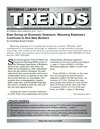
Wyoming Employment Grows from 2010 to 2011
by: Michael Moore, Associate Editor
See related Table and Figures
Wyoming's total employment grew by 3,506 (1.0%) from 2010 to 2011, an indication that the state continued to recover from the recent economic downturn (see Table 1). However, most of this growth was due to the increase in the number of workers classified as "unknown." These are typically nonresident workers who do not possess a Wyoming driver's license, and for whom demographic data are not available. These may be nonresident workers temporarily working in the natural resources & mining or leisure & hospitality industries, or recent transplants to the state who have not yet obtained a Wyoming driver's license.
The number of females (-2,273, or -1.7%) and males (-3,168, or -2.0%) working in Wyoming decreased from 2010 to 2011. A substantial increase of nonresident workers (8,947, or 16.6%) kept Wyoming's total employment from declining for the third consecutive year.
The addition of older workers and nonresidents offset the loss of workers in all other age groups. Wyoming added 1,065 (2.3%) workers in the 55-64 age group and 474 (3.7%) workers age 65 and older. A significant decline was seen among workers in the 45-54 age group (-2,935, or -4.6%).
The number of workers age 24 and under in Wyoming reached a 20-year low in 2011. In 2008, prior to the downturn, there were 64,754 workers age 24 or under working in Wyoming. Total employment for this age group plummeted over the next three years, and in 2011 there were 13,568 fewer people in this age group working in Wyoming (-21.0%; see Figure 1) compared to 2008. The 2011 total of 51,186 represents the smallest amount of workers age 24 or under in Wyoming dating back to 1992, the earliest year for which R&P has comparable records.
Gender Wage Gap
The wage gap between males and females in Wyoming continued to widen in 2011 as the state continued to recover from the recent economic downturn (see Figure 2). In 2009, females were paid 61.1 cents for every dollar paid to males. By 2011, females were paid 58.5 cents for every dollar paid to males.
Wage disparity in Wyoming has historically been linked to the types of jobs offered to males and females. Males often are hired for jobs in industries that offer higher pay and more hours, such as natural resources & mining and construction. When the economy contracts, as was the case in 2009 and 2010, many males who are employed in these industries lose their jobs, which results in a narrowing of the wage gap.
The gender wage gap was widest in Sweetwater County, where females earned just 45.9% of males' wages, or 45.9 cents per ever dollar paid to males. Other counties in which females earned considerably less than males were Lincoln (48.3%), Sublette (49.7%), Weston (50.9%), and Uinta (51.6%) counties.
In Teton County, females earned 77.4% of the wages earned by males in 2011. The only other counties in which females earned 70% or higher of males' wages were Niobrara (75.6%), Laramie (74.1%), and Goshen (72.6%) counties.
Industry Changes
Several industries grew in total employment from 2010 to 2011. The most substantial growth was seen in Wyoming's natural resources & mining industry (3,251, or 9.2%). Significant increases were also seen in wholesale trade, transportation, & utilities (1,022, or 4.3%) and professional & business services (954, or 3.8%).
Employment in Wyoming's construction industry declined by 7.7% (-3,174) over the year. Employment in this industry has declined consistently since 2009. The only other significant decline was found in information (-176, or -3.4%). Marginal declines of less than 1.0% were seen in retail trade (-0.3%), financial activities (-0.8%), and public administration (-0.7%).
Wyoming wages by county, industry, age, and gender are available from 1992-2011 at http://doe.state.wy.us/LMI/earnings_tables/2012/index.htm.
Associate Editor Michael Moore can be reached at (307) 473-3814 or michael.moore@wyo.gov.



